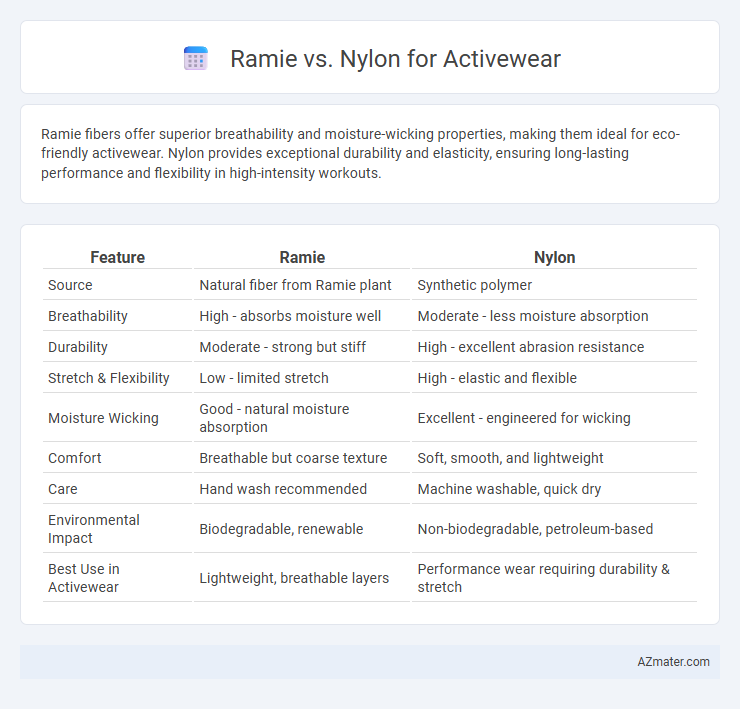Ramie fibers offer superior breathability and moisture-wicking properties, making them ideal for eco-friendly activewear. Nylon provides exceptional durability and elasticity, ensuring long-lasting performance and flexibility in high-intensity workouts.
Table of Comparison
| Feature | Ramie | Nylon |
|---|---|---|
| Source | Natural fiber from Ramie plant | Synthetic polymer |
| Breathability | High - absorbs moisture well | Moderate - less moisture absorption |
| Durability | Moderate - strong but stiff | High - excellent abrasion resistance |
| Stretch & Flexibility | Low - limited stretch | High - elastic and flexible |
| Moisture Wicking | Good - natural moisture absorption | Excellent - engineered for wicking |
| Comfort | Breathable but coarse texture | Soft, smooth, and lightweight |
| Care | Hand wash recommended | Machine washable, quick dry |
| Environmental Impact | Biodegradable, renewable | Non-biodegradable, petroleum-based |
| Best Use in Activewear | Lightweight, breathable layers | Performance wear requiring durability & stretch |
Introduction to Ramie and Nylon in Activewear
Ramie, a natural fiber derived from the stalks of the Chinese nettle plant, offers breathability, moisture-wicking properties, and durability, making it a sustainable choice for activewear. Nylon, a synthetic polymer known for its exceptional strength, elasticity, and quick-drying capabilities, enhances performance and comfort in athletic garments. Both materials serve distinct roles in activewear, with ramie emphasizing eco-friendliness and natural comfort, while nylon delivers resilience and stretch in high-intensity activities.
Fabric Origins and Production Processes
Ramie is a natural fiber derived from the stalks of the *Boehmeria* plant, primarily cultivated in China and East Asia, and undergoes a labor-intensive retting process to extract the fiber, which is then spun into yarn suitable for breathable, moisture-wicking activewear fabrics. Nylon, a synthetic polymer invented in the 1930s by DuPont, is produced through a petrochemical process involving the polymerization of hexamethylene diamine and adipic acid, resulting in a strong, lightweight, and highly durable fiber favored for moisture resistance and elasticity in activewear. The renewable, biodegradable nature of ramie contrasts with the energy-intensive, non-renewable production process of nylon, impacting their sustainability profiles in activewear manufacturing.
Durability: Ramie vs Nylon Performance
Nylon outperforms ramie in durability for activewear due to its high tensile strength and resistance to abrasion, making it ideal for intense physical activities. Ramie, while naturally strong and resistant to wrinkles, lacks the elasticity and stretch recovery found in nylon, reducing its performance under repeated stress. Nylon's moisture-wicking properties and quick drying also contribute to its overall durability and longevity in activewear applications.
Moisture Management and Breathability
Ramie fibers offer superior moisture-wicking properties by naturally absorbing and releasing moisture quickly, enhancing comfort during intense physical activities. Nylon provides excellent breathability due to its lightweight synthetic structure but tends to retain moisture longer, potentially causing discomfort. For activewear focused on moisture management and breathability, ramie ensures faster drying and better air circulation, whereas nylon excels in durability and elasticity.
Comfort and Skin Sensitivity
Ramie fabric offers superior breathability and natural moisture-wicking properties, making it highly comfortable and gentle on sensitive skin compared to nylon. Nylon, while durable and stretchy, can trap heat and cause irritation or allergic reactions for those with sensitive skin. Choosing ramie activewear enhances comfort by reducing sweat accumulation and minimizing skin irritation during prolonged physical activity.
Eco-Friendliness and Sustainability
Ramie, a natural fiber derived from the stalks of the Chinese grass plant, offers superior eco-friendliness compared to nylon due to its biodegradability and minimal pesticide use during cultivation. Nylon, a synthetic polymer made from petrochemicals, has a higher environmental impact due to greenhouse gas emissions during production and persistent microplastic pollution from washing. Choosing ramie for activewear supports sustainable practices by reducing reliance on fossil fuels and promoting renewable, biodegradable materials.
Weight and Flexibility Comparison
Ramie fabric is significantly lighter than nylon, offering enhanced breathability and natural moisture-wicking properties ideal for activewear designed for hot climates. Nylon provides superior flexibility and elasticity, ensuring greater stretch and recovery which supports dynamic movements during high-intensity workouts. Choosing between ramie and nylon depends on whether lightweight breathability or durable stretch is prioritized in activewear performance.
Care, Maintenance, and Longevity
Ramie fabric offers natural durability and breathability, requiring gentle hand washing to maintain its strength and prevent fiber weakening, making it ideal for eco-conscious activewear users. Nylon, known for its high tensile strength and resistance to abrasion, withstands machine washing and dries quickly, ensuring long-lasting performance through rigorous workout routines. Proper care of both materials, such as avoiding harsh detergents for ramie and minimizing heat exposure for nylon, significantly extends the lifespan and maintains the vibrant appearance of activewear.
Cost and Market Availability
Ramie fabric is generally more affordable than nylon, making it an attractive option for budget-conscious activewear manufacturers. However, nylon dominates the market due to its superior durability, moisture-wicking properties, and widespread availability in various blends and finishes. While ramie is less common and often limited in supply, nylon's extensive production ensures consistent market availability and diverse options for performance-focused activewear.
Choosing the Best Fabric for Your Active Lifestyle
Ramie offers excellent breathability, moisture-wicking properties, and natural antimicrobial benefits, making it a sustainable choice for activewear. Nylon provides superior durability, stretch, and quick-drying capabilities, ideal for high-intensity workouts and prolonged activity. Selecting the best fabric depends on balancing eco-friendly features with performance needs like elasticity and moisture management.

Infographic: Ramie vs Nylon for Activewear
 azmater.com
azmater.com